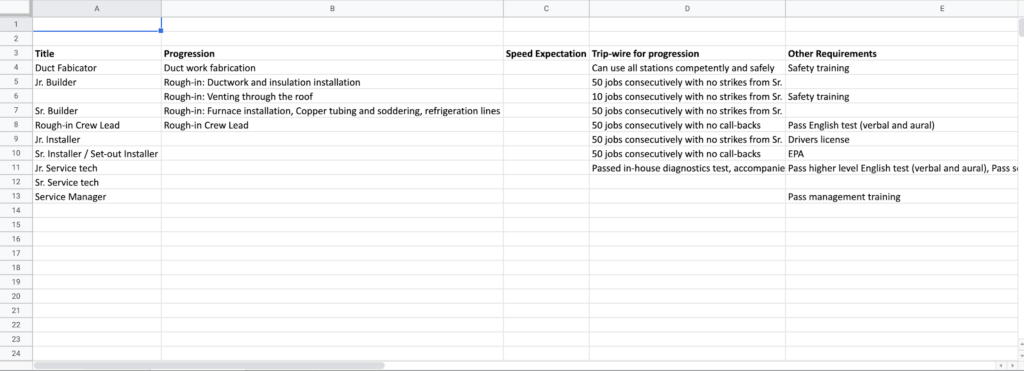- How to identify key roles in the organization.
- How to create a specific path for employees who want to advance within the company.
- How to identify outliers and natural leaders with the business.
- Why on-the-job training is so effective.
- How to create sequences to measure employees’ success.
This piece will serve as a companion to our article about Creating a Skills Matrix.
When you, the new owner, enter a company, you need to figure out how things work, which is where the skills matrix comes in. It’s vital for new owners to understand how each part of the job is done, as well as how capable each of their new employees is.
If creating a skills matrix is downloading a brain, then building a training sequence for career progression could be considered uploading that brain.
The skills matrix allows you to identify the key tasks and roles within an organization. In many cases, those roles wouldn’t have been well-defined before you took over. But by defining each role clearly, you can start to see how people in the organization can progress from one position to the next.
Establishing this trajectory also helps alleviate any resentment in the event that you need to make an outside hire to fill a position. If no one in the organization is qualified to be a service tech, you can explain to folks why you had to hire a qualified service technician while existing employees worked to achieve that level.
Train and Develop Employees: Identifying Roles
…once you have this trajectory in place, you need to create a system that will actually help people rise through the organization.
That said, once you have this trajectory in place, you need to create a system that will actually help people rise through the organization.
The best way to do this is by setting up a series of training sequences that have definitive skill sets that need to be mastered before moving on. You can think of it as on-the-job training or mentorship. It’s a way for people to learn critical tasks from their coworkers.
In the case of one company we acquired that does HVAC installation and servicing for new residential construction, we defined the key tasks as rough-ins, set-outs/change-outs, and service work.
Based on the work we did creating a skills matrix, we were able to define each role in the company and the tripwire for progression. A tripwire is a requirement for a promotion to be considered. Below, you can see how we began to define the roles at the company:

At the base of the organization chart are the people doing ductwork. This is separated into four main sub-tasks, the most advanced of which are soldering and wiring.
Once they’ve mastered the soldering and wiring, they can move up to the set-out position; these are the folks who install the air conditioner units and wire them and the thermostats. Once they’ve mastered both of these roles, they are on the road to becoming a service technician.
By specifying each task associated with these roles, we were able to set expectations and goals. If someone wants to be a service tech, we could show them how to get there over a period of two years. That’s because we knew how long it would take to master each role.
Moving Up
Someone starting at the bottom at this company will work in ductwork. They’ll learn the ropes from those who already know how to do the job. Once they’ve proven they’ve mastered that stage by accomplishing the trip-wire we outlined, they are eligible for promotion.
They will be considered for advancement when the replacement for their current position is in place and the need for the new position is acute. Each level-up is tied to wage increases and new benefits.
The whole process creates an incentive for people to stay with the company and get better at their jobs. As more people get better at their jobs, an organization has little option but to grow.
In nearly all cases, when you take over a business you’ll find that sequences like this never existed. It’s very common for owners to juggle this information in their heads without setting out any sort of clear milestones.
In the past at this business, the highest level anyone could reach below management was set-out technical/installer, and that was never attainable for most people. So creating a training sequence ensured that everyone had the same opportunity to rise to the highest positions (which are now service technician and later service manager)
Benefits of On-The-Job Training
This type of on-the-job training has a number of benefits. For one, well-trained and highly skilled employees will increase productivity and help grow the business. It also has the benefit of not costing the business too many lost working hours. If you were offering a separate training period, people wouldn’t be able to work, which would mean lost revenue for the company.
Moreover, on-the-job training can create happier, more loyal employees since they now have a clearly defined way to rise in the company. These happy and loyal workers also generate a healthy pool of promotable employees. This will pay dividends in the future when you’re looking to fill management positions. If you have loyal workers who know the job well, they’re going to make great managers.

If you’re looking to hire people from outside the company though, a company that promotes learning and self-fulfillment is more likely to attract high-quality candidates. And if people know they need to back-fill their current position in order to get a promotion, they will be more interested in training their colleagues – or even recruiting from outside of the organization.
This kind of flexibility means never having to turn down work because your top employees are unavailable.
Finally, if many people at your company are going through the same training process, you’ll have more people who can fill in for a coworker in the event that someone can’t do their job. This kind of flexibility means never having to turn down work because your top employees are unavailable.
Create Training Activities and Evaluation Methods
Once you’ve determined what each role in the company is and you’ve identified what the workers need to do in each possession, you can start designing training activities for your workers.
Lydia Hooper is a blogger who covers data visualization and information design. According to Hooper, there are five stages of a successful training process:
- Assess needs and resources
- Motivate trainers, learners, and learners’ supervisors to participate
- Design training appropriate for the target audience
- Deliver employee training using methods that will lead to key results (ie: On-the-job training)
- Evaluate successes and areas for improvement and report findings
Depending on the work, this can include a quick and short explanation of a particular process or product, as well as a hands-on demonstration of the task they need to perform on the job.
Once you’ve determined training activities, it’s always important to assess whether people are improving and meeting the standards of each position.
Team leaders will have been largely responsible for training their coworkers. This has a lot of benefits, given that your employees are familiar with the company goals, company standards, culture, strengths, and weaknesses. You know they will be able to train others effectively. They will also be able to give feedback on how their coworkers are progressing. Encourage candid responses from team leaders when assessing how workers are doing at each task. This will help you evaluate the progress of each person.
Conclusion
Once you’ve delineated a clear career path for your workers – an employee development plan – you can show them how to progress through the organization. It allows them to set their own goals and have something to work toward.
It’s a way to incentivize your best employees to rise through the ranks, and it also serves to duplicate the behavior of already-successful workers.
These sequences will allow any owner the ability to avoid the pitfalls of envy and resentment that can come with hiring someone from outside of the organization. It allows them to point out skill gaps in the organization while encouraging people to rise up and fill those gaps themselves.
Helping people rise up and better themselves is the responsibility of servant leaders and is part of Empowered Stewardship, something we consider a core value.
Have you seen a good example of employee training programs? Let us know in the comments below. If you found this post useful, please share it with your colleagues.
If you think you’re interested in becoming an effective servant leader yourself, feel free to reach out to Acquira. Our Acceleration Gauntlet is designed to help you begin your business purchase journey. If you'd like to see how we can help, schedule a call with us now and we'll reply very shortly.
Key Takeaways
- Define skillsets that need to be mastered before promotion is possible.
- Remove envy and resentment when making outside hires through a clear training and ascension plan.
- On-the-job training has a number of benefits, including creating loyal and competent workers.
- Learn how to assess whether people are meeting the standards for each position through a team feedback loop and evaluating progress.
Acquira specializes in seamless business succession and acquisition. We guide entrepreneurs in acquiring businesses and investing in their growth and success. Our focus is on creating a lasting, positive impact for owners, employees, and the community through each transition.



